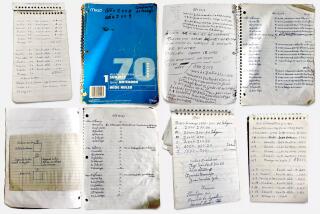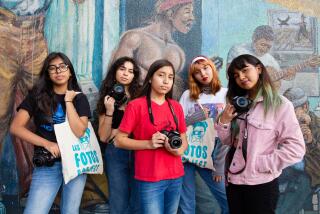Sunday Shutterbugs : Snapshot Photographers Swarm to Latino Festivities to Capture Memories at $5 a Click
- Share via
For the man and woman leaving Santa Rosa Catholic Church in San Fernando, it was a once-in-a-lifetime moment. They had just gotten married, and they were sharing their joy with family and friends on the steps outside.
The scene just begged for a picture. And a group of perfect strangers outside the church were just begging to take it.
Like paparazzi outside a star-studded Hollywood premiere, the swarm jockeyed for position as the unsuspecting celebrants carried on. Several of the photographers clutched developing photos of the festivities between their teeth as they continued to snap away.
Soon, the unhired shutterbugs made it clear they were not collecting snapshots for their personal scrapbooks. The wedding party would be able to cherish this memory forever--at $5 a shot.
Like an army, about a dozen free-lance photographers, armed with Polaroid cameras and dozens of small cardboard frames, converge each weekend on parish churches in Pacoima, San Fernando and other Latino enclaves in the northeast San Fernando Valley where weddings, baptisms and birthdays are taking place.
It is a custom carried over from Mexico, and the focus is on anyone who will pose and pay. The photographers compete against each other in front of their subjects, thrusting photos at them, flattering them and generally doing anything they can to sell the snapshots.
“How much you sell depends on your ability to be a salesman,” Gonzalo Aldama said. One of Aldama’s more effective techniques is to tell preening male subjects they resemble actor Charles Bronson.
The photographers will usually shoot the first pictures in hopes that a potential customer will be encouraged into posing for another. The snapshots are available for sale within minutes after they are taken. After being ripped from the camera, the photos are popped into a specially made frame, ready for presentation.
Earnings Vary
If he hustles, a photographer can make as much as $100 a day, Aldama said. However, most make just “enough for certain expenses--like gasoline, beers and horses,” he said.
And sometimes things don’t click at all. “I can be there all day and sometimes I don’t make a cent,” Aldama said.
Like their celebrity-seeking counterparts, the amateur photographers have formed an informal, tightknit society with unwritten rules and an understanding about the perils of unsolicited photography. Some become regulars at certain churches. Newcomers are frowned upon.
Though they are competitors, Aldama and Tany Bracamantes meet each weekend at Santa Rosa and St. Ferdinand’s Catholic Church in Pacoima. The rest of their week could not be more dissimilar: Aldama, of Montebello, studies photography at East Los Angeles College, while Bracamantes is a construction worker in Tijuana who commutes to the churches on weekends.
Serious Work
Although it is only a weekend pursuit, the photographers take their work seriously.
“It’s harder than being a professional photographer,” Aldama said. “I have to take a good shot because if I don’t, I won’t sell it. Professional photographers can touch things up. We can’t.”
Buyers, like the photographers, are mostly of Mexican descent, Bracamantes said. Those who rarely buy the Polaroid shots, photographers maintain, are people from other Latin American or Spanish-speaking countries who are not familiar with the custom.
“If they’re from Argentina or Cuba, they won’t buy them,” said a female photographer who asked that her name not be used. “The only ones who consume our products are Mexicans.”
Some church officials said they regard the photo vendors as a nuisance. But Terry Vinson, a secretary at Santa Rosa, said most parishes recognize that the photographers are only trying to earn a living.
“Some people just put up with it,” Vinson said.
At a recent wedding, Aldama persuaded an elderly woman, Eulogia Tapia, to allow him to take a picture of her and her husband.
“Please, Abuelita (grandmother), let me take it,” Aldama said.
When she saw the finished product, Tapia was pleased.
“It’s very nice and clear,” she told Aldama, handing him $5.
More to Read
Sign up for Essential California
The most important California stories and recommendations in your inbox every morning.
You may occasionally receive promotional content from the Los Angeles Times.









